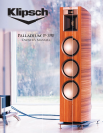
Page 8 Page 9
Connecting the Loudspeakers - 2Cables, Crossovers and Connections
For best results, connect your loudspeakers with purpose-designed loudspeaker
cable. The cables to both loudspeakers should be of equal lengths and be of a gauge
sucient to drive the speakers comfortably without any loss of power in the bass at
high volumes.
We recommend a minimum wire diameter of 14 AWG. If you are in doubt, ask your
Klipsch dealer for advice. Because of the location of the terminal panel, you should
connect the loudspeakers before you connect the amplier. If you are replacing a
existing pair of loudspeakers, we suggest you de-wire the amplier rst.
There are two crossover networks in the P-39F. One panel is a dedicated bass net-
work. The second panel is a network for the midrange and treble units . The net-
works terminate in a custom designed tri-wire terminal panel located above the loudspeaker pedestal, under
the loudspeaker. As the bass, midrange and treble elements can be separately connected, three types of wiring
are possible: standard wiring, bi-wiring and tri-wiring.
The terminal panel accepts a wide variety of connectors, including spade lugs, pins or bare
wire. If you have no preference, your dealer can advise you as to appropriate connectors.
The instructions in this user guide relate to bare wire. If you use alternative connectors,
consult your dealer or the hardware supplier’s literature.
Standard loudspeaker cable comprises two conductors with one core having a ridge or
stripe. Connect the striped conductor to the Positive (RED) terminal in all cases. This will
ensure that the loudspeakers are properly connected and in phase.
Split the cable to a depth of 1½”. Strip ½” of insulation. If the wire is stranded, lightly twist
the ends together to ensure no stray ends of cable can short adjacent terminals.
Connecting a Terminal
Partially unscrew the terminal.
1: In the base of the terminal, there is a hole. Insert the bare end of the wire into
the hole.
2: Tighten each connector hand tight. After connecting all the terminals, check
that there are no stray strands of bare wire that can reach across and short out
adjacent terminals.
3: When you are sure that all the connections are correct, insert the Allen key into
the socket in each terminal head and tighten fully to secure them. DO NOT
over-tighten the terminals, or you may damage them. (An Allen key (hex
wrench) is provided in the accessories carton.)
The P 39-F Terminal Panel
As supplied, positive and negative terminals of the Treble, Midrange and Bass Terminal pairs are strapped to-
gether with a three-way strap. A pair of two-way straps is provided in the accessories carton for bi-wiring. This
is how you should prepare the terminal panel for each wiring option.
HFHF
MFMF
LFLF
HFHF
MFMF
LFLF
HFHF
MFMF
LFLF
Standard Connection Bi-wiring Connection Tri-wiring Connection
No preparation
needed
Loosen the terminals.
Remove the triple straps and insert
the twin straps as shown
Re-tighten all terminals hand tight
Loosen the terminals.
Remove the triple straps
Re-tighten all
terminals hand tight
Standard (Single) Wiring
The straps are left in place as supplied. Connection may be made to any pair of terminals.
You will need two loudspeaker cables of equal lengths, one for each loudspeaker.
Partially unscrew one Positive and one Negative terminal. Connect the Positive (+ RED) terminal of the loud-
speaker to the striped conductor, or (if you are using custom cable) to the conductor designated by the cable
manufacturer. Connect the Negative (– BLACK) terminal to the plain conductor. Do not connect the amplier
at this time.
HFHF
MFMF
LFLF
HFHF
MFMF
LFLF
Right Speaker Left Speaker
AMPLIFIER
Important Note. After connecting and placing the loudspeaker upright, the connections will be hidden from
view. We strongly recommend that you identify each cable to eliminate possible diculties down the line.













